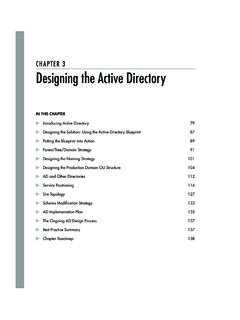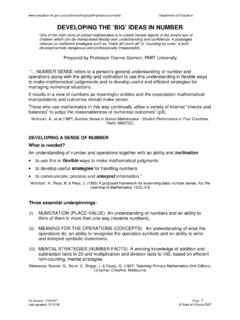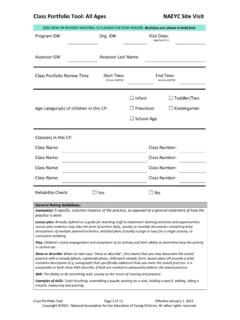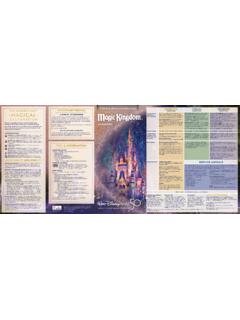Transcription of C#
1 C#. C#. About the Tutorial C# is a simple, modern, general-purpose, object-oriented programming language developed by Microsoft within its .NET initiative led by Anders Hejlsberg. This tutorial covers basic C# programming and various advanced concepts related to C#. programming language. Audience This tutorial has been prepared for the beginners to help them understand basics of c# Programming. Prerequisites C# programming is very much based on C and C++ programming languages, so if you have a basic understanding of C or C++ programming, then it will be fun to learn C#. Disclaimer & Copyright Copyright 2014 by Tutorials Point (I) Pvt. Ltd. All the content and graphics published in this e-book are the property of Tutorials Point (I) Pvt. Ltd. The user of this e-book is prohibited to reuse, retain, copy, distribute or republish any contents or a part of contents of this e-book in any manner without written consent of the publisher.
2 We strive to update the contents of our website and tutorials as timely and as precisely as possible, however, the contents may contain inaccuracies or errors. Tutorials Point (I) Pvt. Ltd. provides no guarantee regarding the accuracy, timeliness or completeness of our website or its contents including this tutorial. If you discover any errors on our website or in this tutorial, please notify us at i C#. Contents About the Tutorial .. i i i Disclaimer & Copyright .. i Contents .. ii 1. 1. Strong Programming Features of C# .. 1. 2. 3. The .Net Framework .. 3. Integrated Development Environment (IDE) for C#.. 4. Writing C# Programs on Linux or Mac 4. 3. PROGRAM 5. Creating Hello World Program .. 5. Compiling and Executing the Program .. 6. C# Keywords .. 10. 4. BASIC 12. The using Keyword .. 13. The class Keyword .. 14. Comments in C#.. 14. Member Variables .. 14. Member 14. Instantiating a Class .. 14. Identifiers.
3 15. C# Keywords .. 15. 5. DATA 17. ii C#. Value Type .. 17. Reference Type .. 18. Object Type .. 19. Dynamic Type .. 19. String 19. Pointer Type .. 20. 6. TYPE CONVERSION .. 21. C# Type Conversion Methods .. 22. 7. 24. Defining 24. Initializing 25. Accepting Values from User .. 26. Lvalue and Rvalue Expressions in C#: .. 26. 8. CONSTANTS AND 28. Integer 28. Floating-point Literals .. 29. Character 29. String 30. Defining 31. 9. 33. Arithmetic 33. Relational 35. Logical 38. Bitwise Operators .. 40. Assignment Operators .. 43. Miscillaneous Operators .. 46. iii C#. Operator Precedence in C# .. 48. 10. DECISION 51. if 52. Statement .. 54. The 56. Nested if Statements .. 58. Switch Statement .. 60. The ? : 65. 11. LOOPS .. 66. While Loop .. 67. For 69. Loop .. 72. Nested Loops .. 75. Loop Control Statements .. 78. Infinite Loop .. 83. 12. ENCAPSULATION .. 84. Public Access Specifier .. 84. Private Access Specifier.
4 86. Protected Access Specifier .. 88. Internal Access Specifier .. 88. 13. 91. Defining Methods in C#.. 91. Calling Methods in C# .. 92. Recursive Method Call .. 95. Passing Parameters to a Method .. 96. Passing Parameters by Value .. 97. iv C#. Passing Parameters by Reference .. 99. Passing Parameters by 100. 14. NULLABLES .. 104. The Null Coalescing Operator (??).. 105. 15. 107. Declaring Arrays .. 107. Initializing an 107. Assigning Values to an 108. Accessing Array Elements .. 108. Using the foreach Loop .. 110. C# Arrays .. 111. Multidimensional Arrays .. 112. Two-Dimensional 112. Jagged 115. Passing Arrays as Function 117. Param Arrays .. 118. Array Class .. 119. Properties of the Array 119. Methods of the Array 120. 16. 124. Creating a String Object .. 124. Properties of the String Class .. 126. Methods of the String Class .. 126. 17. STRUCTURES .. 135. Defining a 135. Features of C# 137. v C#. Class versus Structure.
5 138. 18. ENUMS .. 141. Declaring enum Variable .. 141. 19. 143. Defining a 143. Member Functions and Encapsulation .. 145. C# Constructors .. 148. C# Destructors .. 151. Static Members of a C# Class .. 152. 20. 156. Base and Derived 156. Initializing Base Class .. 158. Multiple Inheritance in C#.. 160. 21. 163. Static 163. Dynamic Polymorphism .. 165. 22. OPERATOR OVERLOADING .. 170. Implementing the Operator Overloading .. 170. Overloadable and Non-Overloadable 173. 23. 181. Declaring Interfaces .. 181. 24. NAMESPACES .. 184. Defining a Namespace .. 184. The using 185. Nested 187. vi C#. 25. PREPROCESSOR DIRECTIVES .. 190. Preprocessor Directives in C#.. 190. The #define Preprocessor .. 191. Conditional 192. 26. REGULAR EXPRESSIONS .. 194. Constructs for Defining Regular Expressions .. 194. Character 194. Character Classes .. 196. Grouping Constructs .. 198. Quantifier .. 199. Backreference Constructs .. 200.
6 Alternation 201. Substitution .. 202. Miscellaneous Constructs .. 202. The Regex Class .. 203. 27. EXCEPTION HANDLING .. 208. Exception Classes in C# .. 209. Handling Exceptions .. 210. Creating User-Defined 212. Throwing 213. 28. FILE 214. C# I/O Classes .. 214. The FileStream Class .. 215. Advanced File Operations in C# .. 217. Reading from and Writing to Text Files .. 218. The StreamReader Class .. 218. The StreamWriter Class .. 220. vii C#. Reading from and Writing into Binary files .. 222. The BinaryWriter 224. Windows File System .. 228. The DirectoryInfo Class .. 228. The FileInfo Class .. 230. 29. 234. Specifying an Attribute .. 234. Predefined Attributes .. 234. AttributeUsage .. 234. Conditional .. 235. Obsolete .. 237. Creating Custom Attributes .. 238. Constructing the Custom Attribute .. 239. Applying the Custom Attribute .. 241. 30. 243. Applications of Reflection .. 243. Viewing Metadata .. 243.
7 31. 251. Accessors .. 251. Abstract 255. 32. INDEXERS .. 259. Use of Indexers .. 259. Overloaded 262. 33. 266. Declaring Delegates .. 266. Instantiating Delegates .. 266. viii C#. Multicasting of a Delegate .. 268. Using Delegates .. 270. 34. 272. Using Delegates with Events .. 272. Declaring Events .. 272. 35. COLLECTIONS .. 279. ArrayList 280. Hashtable 284. SortedList Class .. 288. Stack Class .. 292. Queue Class .. 295. BitArray 297. 36. GENERICS .. 302. Features of Generics .. 304. Generic Methods .. 304. Generic 306. 37. ANONYMOUS METHODS .. 309. Writing an Anonymous 309. 38. UNSAFE 312. Pointers .. 312. Retrieving the Data Value Using a Pointer .. 313. Passing Pointers as Parameters to Methods .. 314. Accessing Array Elements Using a Pointer .. 315. Compiling Unsafe Code .. 316. 39. 318. Thread Life 318. ix C#. Properties and Methods of the Thread Class .. 319. Creating 323. Managing Threads .. 324. Destroying 326.
8 X C#. 1. OVERVIEW. C# is a modern, general-purpose, object-oriented programming language developed by Microsoft and approved by European Computer Manufacturers Association (ECMA). and International Standards Organization (ISO). C# was developed by Anders Hejlsberg and his team during the development of .Net Framework. C# is designed for Common Language Infrastructure (CLI), which consists of the executable code and runtime environment that allows use of various high-level languages on different computer platforms and architectures. The following reasons make C# a widely used professional language: It is a modern, general-purpose programming language It is object oriented. It is component oriented. It is easy to learn. It is a tructured language. It produces efficient programs. It can be compiled on a variety of computer platforms. It is a part of .Net Framework. Strong Programming Features of C#. Although C# constructs closely follow traditional high-level languages, C and C++.
9 And being an object-oriented programming language. It has strong resemblance with Java, it has numerous strong programming features that make it endearing to a number of programmers worldwide. Following is the list of few important features of C#: Boolean Conditions Automatic Garbage Collection Standard Library Assembly Versioning Properties and Events 1. C#. Delegates and Events Management Easy-to-use Generics Indexers Conditional Compilation Simple Multithreading LINQ and Lambda Expressions Integration with Windows 2. C#. 2. ENVIRONMENT. In this chapter, we will discuss the tools required for creating C# programming. We have already mentioned that C# is part of .Net framework and is used for writing .Net applications. Therefore, before discussing the available tools for running a C# program, let us understand how C# relates to the .Net framework. The .Net Framework The .Net framework is a revolutionary platform that helps you to write the following types of applications: Windows applications Web applications Web services The.
10 Net framework applications are multi-platform applications. The framework has been designed in such a way that it can be used from any of the following languages: C#, C++, visual Basic, Jscript, COBOL, etc. All these languages can access the framework as well as communicate with each other. The .Net framework consists of an enormous library of codes used by the client languages such as C#. Following are some of the components of the .Net framework: Common Language Runtime (CLR). The .Net Framework Class Library Common Language Specification Common Type System Metadata and Assemblies Windows Forms and AJAX. Windows Workflow Foundation (WF). Windows Presentation Foundation Windows Communication Foundation (WCF). LINQ. For the jobs each of these components perform, please see - Introduction, and for details of each component, please consult Microsoft's documentation. 3. C#. Integrated Development Environment (IDE) for C#.


















